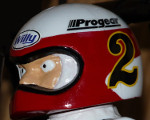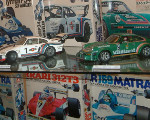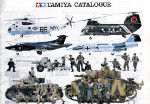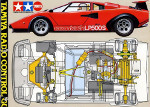 Tamiya re-releases
Tamiya re-releases
In addition to its very wide modern RC offering, Tamiya long remained the only manufacturer to re-release models which production was stopped for years or decades. From 2013, new "historical" manufacturers joined the juicy re-release market, at least for those who are still in activity. Associated launch their re-release program with their oustanding RC10 Gold, the buggy that changed RC racing in the middle of the 80's. Kyosho followed in 2014 with the re-release of their Scorpion, another iconic buggy for the early 80's.
- Details
 Tamiya drivers interviews
Tamiya drivers interviews
This is a worldwide exclusivity: based upon an original idea from BaraToZ, a fellow member of the Vintage-RC forum, I hereby publish his interviews of several famous Drivers from Tamiya's scuderia.
Between the late 70's and late 90's, a gifted generation of drivers became famous worldwide as the Tamiya dream team. Names like Frank Evans, Willy, Harry Hurryup, "Frantic" Freddy Wilson still bring memories to those of us who were fans of car racing back then.
These are the heros BaraToZ interviewed for us.
- Details
 Tamiya Museum
Tamiya Museum
Far far away in a country where they say the sun rises, some say there is a temple dedicated to static and RC models where the outmost mythical realizations of a manufacturer called Tamiya are gathered. Some also say that pilgrims prayed there for models to be re-released and these prayers were heard. Some even say that the persons working at the temple spend hours every day to clean innumerable finger prints left on the display windows... and hours to mop up drool puddles left by pilgrims in admiration trance ![]()
- Details
 Tamiya Off-Road chassis
Tamiya Off-Road chassis
Following the On-Road chassis platforms article, let's review Tamiya's industrial and commercial strategies in the Off-Road category. Again, I will refer to chassis platforms, and still for a question of logic, the models release chronology will not be respected.
Early, Tamiya offered off-road models, the first one being their 4th model, even though it is quite special. By the end of year 1979, only 3 years after releasing the Porsche 934 turbo RSR, Tamiya unveils their first buggy series. During all the 80's, platforms and models follow one another for Tamiya and about all other manufacturers at the time, creating a fantastic fever for these models. Starting in 1985, RC knows its “golden era” mainly because of the buggy craze: this will end at the beginning of the 90's when Tamiya decides to make a radical change on the market (see the story of Tamiya On-Road chassis about this).
- Details
 Tamiya Catalogs
Tamiya Catalogs
A few years before they started publishing the RC Guide Books, Tamiya was already editing yearly catalogues to present their whole range of products. At first, they only presented static models, but Tamiya entering the RC world revealed the need of a dedicated version for this new market. Whereas the catalogues were presenting both static and RC models, the RC Guide Books were exclusively dedicated to RC. I guess this means that Tamiya considered from the begining that static models fans could become RC fans, but not the opposite. Sorry for "shelf-queens" fans, but this smells like pure logic. Of course, this is no judgment in anyway for shelf-queens fans: everybody is free to live its passion the way he wants.
- Details
 Tamiya RC Guide Books
Tamiya RC Guide Books
One of Tamiya's strengths is to have started publishing catalogues very soon after they started on the model market, editing one catalogue for the static model range of products, and another one dedicated to RC models. In France, they were sold in toy stores and their content was a great surprise for those who bought them. Printed on glossy paper, the overall quality and pictures were true dream teasers and soon the young reader would become a customer after some parent harassment ![]() ). I remember spending hours reading the 1987 RC catalogue (although my skills in English were almost non existent by the time).
). I remember spending hours reading the 1987 RC catalogue (although my skills in English were almost non existent by the time).
- Details
 Tamiya On-Road chassis
Tamiya On-Road chassis
A radio-controlled model is basically a chassis and a bodyshell, exactly what Tamiya did understand to its full extend since their introduction into the RC world back in 1976. The 2 star brand specialized in declining several models using a common chassis but varying bodies and rims. The interest in doing so is a triple combo:
- the offering range is wider
- development costs are limited
- the industrial tool is made more profitable
- Details
 Tamiya Drivers
Tamiya Drivers
Probably a strange article, but as far as I know, very few information is available about this: some of our dear models are driven by... a driver. Those very same drivers who can't scream their terror when we make them go full throttle. Nevertheless, sometimes we paint them, sometimes we forget or don't dare to give them a face. Some of them do even have a name, others are emblematic of the vehicle their drive, and some don't exist but make us dream of who they could be.
Anyway, I'm sure that if mine were alive, they would open the window and vomit because of what I give them ![]()
- Details
Tamiya: the company
Tamiya Incorporated is a Japanese manufacturer of static models, radio controlled vehicles, educational models powered by batteries and solar energy, paints, tools and other supplies for modeling. The company was founded in Japan in 1946 by Yoshio Tamiya but only entered the model world in 1948 with the production of a wooden ship model.
 Tamiya's slogan is "First in Quality Around the World", originating in an outstanding moulding quality and accurate parts fitting close to perfection. This precision combined to a high scale detail standard make Tamiya's quality famous among hobbyists around the world.
Tamiya's slogan is "First in Quality Around the World", originating in an outstanding moulding quality and accurate parts fitting close to perfection. This precision combined to a high scale detail standard make Tamiya's quality famous among hobbyists around the world.
The two star logo can be found on every Tamiya product. The red color stands for passion and the blue color for precision.
- Details











